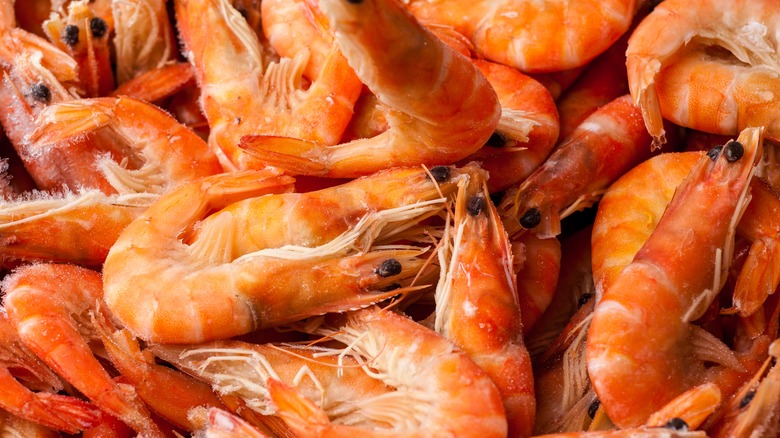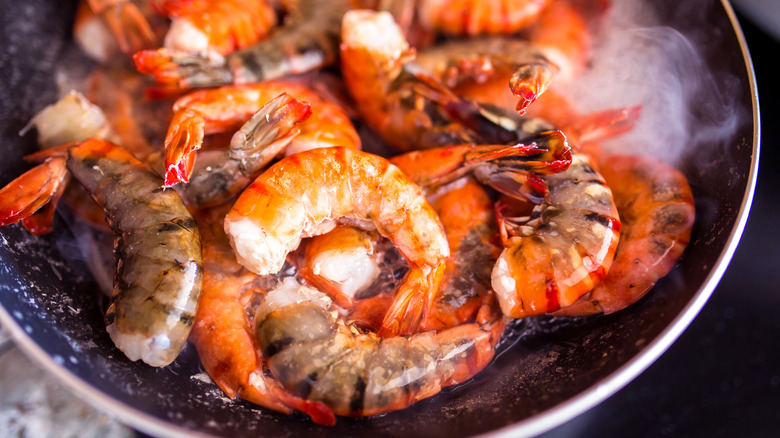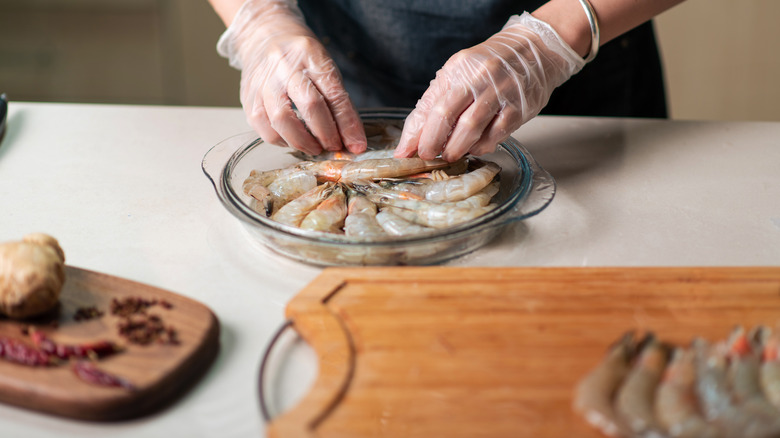The Science Behind Why Shrimp Changes Color As It Cooks
To seafood enthusiasts, nothing is more appealing than bright, beautiful orangey-red shrimp, whether they be served in shrimp cocktail, shrimp scampi, or more region-specific delicacies like Louisiana shrimp étouffée or a Lowcountry seafood boil. Even cooks who are familiar with this popular and delicious shellfish may wonder why it undergoes such a dramatic transformation when cooked, changing from a somewhat unappetizing, cold blueish-grey to that signature ruddy shade that looks so tasty.
The single-word explanation behind this beautiful yet mysterious phenomenon is astaxanthin, a molecule that gives an orange color to shrimp, as well as lobster, crabs, salmon, algae, and other plants. Just like with lobsters, the heat of cooking is what unlocks the reddish color of shrimp. Astaxanthin is usually concealed by proteins called crustacyanin, which make raw shrimp appear blue-grey in color. But once exposed to high heat, crustacyanin breaks down and unravels, allowing us to see the red hues of the astaxanthin underneath. Astaxanthin isn't just there to make shrimp look pretty, though. It serves as a helpful indicator of when your shrimp are perfectly cooked, and even has some of its own unique benefits to offer.
What is astaxanthin and how does it affect the color of shrimp?
Astaxanthin is a xanthophyll carotenoid, a naturally-occurring pigment that is insoluble in water. It is transmitted into shellfish like shrimp and lobster through the organism's food that it consumes in its aquatic environment. Located in the shrimp's exoskeleton, this orange-red molecule is concealed by the aforementioned protein chains called crustacyanin. However, once exposed to high heat — say, in a pot of boiling water — the heat-unstable crustacyanin is destabilized and can no longer hold together, allowing us to see the red hues of the astaxanthin.
Beyond offering a pretty appearance to cooked shrimp, lobster, and an assortment of other organisms, astaxanthin is a powerful antioxidant with several potential health benefits. These include (but are not limited to) supporting the immune system, protecting your skin from UV damage, and contributing to heart health. While we do consume some astaxanthin in the flesh of shrimp, the highest concentrations of the pigment are found in the shells and head — which are usually discarded rather than eaten, in some cultures. If you're looking to get just a smidge of extra antioxidants in your meal, try cooking your shrimp with the shells and heads on — many chefs even say that shell-on shrimp retain more flavor.
Pay attention to the color of your shrimp
While "astaxanthin" may be the fancy name for the pigment in shrimp, using this pigment to your advantage requires no complicated skills. The redness of shrimp, regardless of what you call it, is vital in helping you determine when your shrimp is done cooking. We know that raw shrimp are limp and have a blue-grey color, but from there, it can be hard to judge when they're cooked to perfection.
Partially-cooked shrimp are a bit firmer than raw ones, and maintain some of their translucence and subtle grey coloring. If your shrimp don't look opaque and rosy yet, you should keep cooking them. Once fully-cooked, your shrimp will be firm yet tender, and their astaxanthin will be fully on display, giving them an all-over pinkish hue. They'll also take on a much more curved shape, compared to the straighter bodies of the raw shellfish. Use a thermometer to see if the shrimp have reached 145 degrees Fahrenheit in the thickest part of their bodies, and they'll be ready to serve.
Whether you're craving pasta, grits, risotto, or something else altogether, shrimp can elevate almost any meal. In addition to cooking these tasty seafood treats with their heads and shells on, you should know that you can eat their tails, too! With their higher concentrations of astaxanthin, doing so might be healthier and tastier than you'd think — not to mention a great way to reduce food waste.



